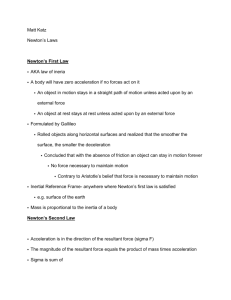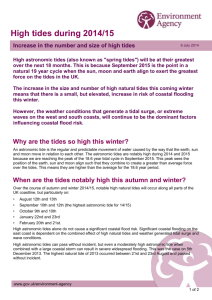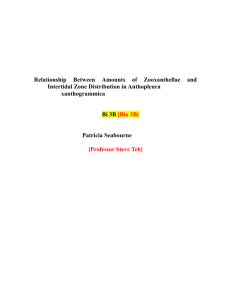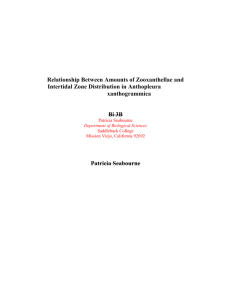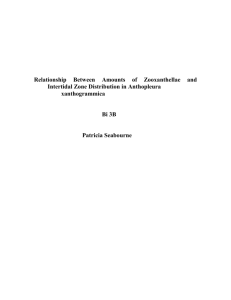Geophysical Final Review
advertisement
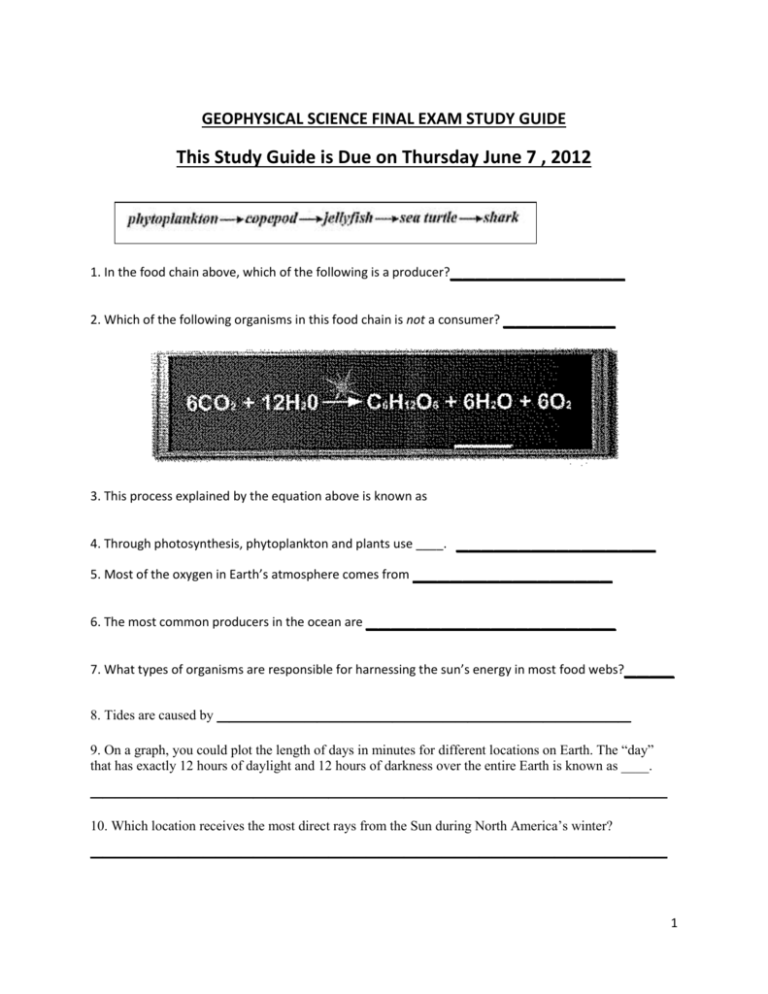
GEOPHYSICAL SCIENCE FINAL EXAM STUDY GUIDE This Study Guide is Due on Thursday June 7 , 2012 1. In the food chain above, which of the following is a producer? ______________ 2. Which of the following organisms in this food chain is not a consumer? _________ 3. This process explained by the equation above is known as ________________ 5. Most of the oxygen in Earth’s atmosphere comes from ________________ 4. Through photosynthesis, phytoplankton and plants use ____. 6. The most common producers in the ocean are ____________________ 7. What types of organisms are responsible for harnessing the sun’s energy in most food webs? 8. Tides are caused by ____ _________________________________ 9. On a graph, you could plot the length of days in minutes for different locations on Earth. The “day” that has exactly 12 hours of daylight and 12 hours of darkness over the entire Earth is known as ____. ______________________________________________ 10. Which location receives the most direct rays from the Sun during North America’s winter? ______________________________________________ 1 11. What causes the cycle of day and night on Earth? _____________________ 12. When the Northern Hemisphere is strongly tilted towards the Sun, a student in the United States ______________________ experiences ____. 13. One revolution of the Earth takes about ______ 14. The force of attraction between two objects is called _______________ 15. Which region on Earth gets the most indirect rays from the Sun during the year? 16. Spring tides happen ________ ____________________________ 17. Describe the cause for Earth’s seasons? ______________________ 18. Which position of the Earth in the diagram above represents the beginning of summer in California? ______________________________________________ ___________________ 20. Which of the following diagrams represents a spring tide?____________ 19. Which of the following diagrams represents a neap tide? 2 21. A scientist has been studying the local tides and notices that today the bay is experiencing the highest high tides and lowest low tides that she has observed yet. _____________________ Which type of tide is the scientist likely experiencing? 22. Productivity at 100 meters reaches a maximum in what month? _______________ 23. From figure 1 above it is reasonable to assume that the base of the photic zone (where net primary production is essentially zero) near Bermuda is generally above the a water depth of ________ 24. Based on the Year 2000 data, the primary production in near surface waters at Bermuda (1m and 40 m) reaches a maximum in what month? ____________________________ 3 A B ____________________________________________________________________________________________ Information: Mass = 279 kg Height at point A = 150 m Height at point B = 75 m 25. Calculate TE for the coaster. 26.If the coaster is moving at 20 m/s and has a mass of 50 kg, how much kinetic energy does it have? 27. What is the potential energy at point A? 28. What is the total energy at point B? 29. What is the kinetic energy at point B? 4 Use the following choices for questions 61-67. a. b. c. d. e. Electromagnetic Energy Heat Energy Nuclear Energy Chemical Energy Mechanical Energy 30. Potential energy is a type of this energy. ________________ 31. Light and electricity are examples of this type of energy. ________________ 32. The energy of a roller coaster moving down a hill is this type of energy. 33. The stored energy in a log before burning. ____________ ________________ 34. This energy is released when the nucleus of an atom splits. ________________ 35. The faster the internal motion of atoms, the more of this energy that is produced. 36. Kinetic energy is a type of this energy. ________ ________________ Coral reefs occur mostly in shallow tropical waters within _______ degrees latitude of Earth's equator. Corals harvest nutrients from ________ called zooxanthellae, which inhabit their cells by the thousands. The presence of _________ associated with the zooxanthellae gives the otherwise nearly colorless corals their strikingly ________ appearance. Living coral consists of colonies of small ________and within their tissues are the zooxanthellae. Energy and oxygen are received from the zooxanthellae via_______________________. 5 FINAL EXAM REVIEW – PART 2: YOU WILL BE GIVEN FORMULAS ON THE EXAM. FOR THIS PACKET, YOU NEED TO FIND THE FORMULAS IN YOUR NOTES. YOU MUST USE THE 4 STEP METHOD. 37. What is the weight of a 100 g rock? 38. If the mass of the car is 12kg and the acceleration is 5 m/s2, what is the force? 39. If Sally travels 10 m in 5 seconds, what is her speed? 40. Calculate GPE for a boulder sitting on a 100 m cliff with a mass of 10kg. 50. What is the KE for the above boulder? 51. What is the TE for the boulder on the cliff system? 6 52. Deanna is pushing on a wall with a force of 3N. If the wall does not move, with how much force is the wall pushing back? What is the net force on the wall? 53. Ricky rows his canoe due west for 40 meter to the campsite. If it took him 13 seconds to cover that distance. What was his velocity? 54. Chilly Willy the Penguin is standing on top of an ice burg at rest. He slips and increases his velocity to 8 m/s in a matter of 5 seconds. What was Chilly Willy the Penguins acceleration? 55. A rubber duck is slowly floating down a stream. It is moving 18 m/s and travels a distance of 289 meters. How much time did it take to cover that distance? 56. A cube of aluminum has a mass of 2.5 grams and measures 2 cm on each side. What is it’s density? Convert the following: 2.5 cm to ___________________ m 5.1 km to ____________________ cm 12 mL to __________________ L 15 g to __________________ dc 24.5 mL to _______________ cm3 57. How many protons does Carbon have? 58. How many electrons does Carbon have? 59. How many neutrons does Carbon have? (show your work) 60. An instrument called a _________________ measures air pressure 61. ____________________ pressure usually is associated with clear skies. 62. A _____________________ measures wind direction. 63. A ____________________ measures wind speed 7 64. STATE NEWTON’S FIRST LAW OF MOTION: 65. STATE NEWTON’S SECOND LAW OF MOTION: 66. STATE NEWTON’S THIRD LAWOF MOTION: 67. How can power be increased? 68. Power can be calculated by multiplying force x distance and dividing by ________________ . 69. When the _______________________ of doing work increases, the power increases. 70. Electrical appliances are rated in ______________________ . 71. Power is the amount of ________________ per unit time. 72. Decide if work is being done in the examples below. a. You carry your science notebook a distance of 20 meters. b. You study all night for your science final exam. c. Your finger pushes down the return key when you are working with the srsd website. d. You give your friend a “high-five” when you both realize you have passed your final exam. 73. If an object is being pushed with twice the force for twice the distance, how much work is being done? 74. Define Potential Energy in five words or less. What is the formula used to find potential energy? 75. Explain in words what the formula for PE means. 8 76. Define Kinetic Energy in five words or less. What is the formula for KE? 77. Explain what the formula for KE means in words. 78. Explain what happens to the KE if velocity is changed. 79. What is the Law of Conservation of Energy? Give an example of the law. 80. Describe what an object that has kinetic energy is doing. 81. What is the total energy of a system. How is the TE found? Explain how an object gains and loses KE and PE. 82. Decide whether each item below describes kinetic energy or potential energy. a. A pile of coal that will be used for fuel. b. A flag blowing in the wind. c. A new car battery. d. A marble rolling down a hallway. e. A hammer held above a nail. f. An unlit firecracker. 83. What are the factors that determine potential energy? Kinetic energy? 84. What is gravitational potential energy? 85. If a teacher pushes as hard as they can on the chalkboard, how much work is being done? Why? 86. What is inertia? 87. Which has more inertia: 5 kg bowling ball or a 2 kg plastic ball? 88. Neglecting air friction, if a ball is rolled down a hill and goes up another hill, how far up the hill will it roll? 9 89. If the force on an object remains the same, what happens to the object’s acceleration if the mass is increased? 90. If the force acting on an object doubles, what happens to the acceleration? Why? 91. If the mass of an object doubles, what happens to the acceleration? Why? 92. What acceleration will a person in free fall have if air resistance is neglected? 93. What are the units of gravity? What is the value of gravity? How do you calculate weight? 94. Explain the action/reaction forces that propel a fish forward through the water. 95. If a 250 Newton boy is sitting on the ground, how much of a force is the ground exerting on him? 96. When a bug hits a windshield, will the windshield exert a greater force on the bug than the bug exerts on the windshield? Explain your answer. 97. Define species. 98. Define community. 99. Define population. 100. What type of fish was raised in the back of the classroom? 10



